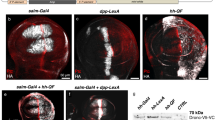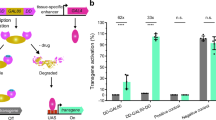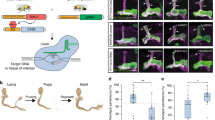Abstract
In Drosophila, the GAL4/UAS/GAL80 repressible binary expression system is widely used to manipulate or mark tissues of interest. However, complex biological systems often require distinct transgenic manipulations of different cell populations. For this purpose, we recently developed the Q system, a second repressible binary expression system. We describe here the basic steps for performing a variety of Q system experiments in vivo. These include how to generate and use Q system reagents to express effector transgenes in tissues of interest, how to use the Q system in conjunction with the GAL4 system to generate intersectional expression patterns that precisely limit which tissues will be experimentally manipulated and how to use the Q system to perform mosaic analysis. The protocol described here can be adapted to a wide range of experimental designs.
This is a preview of subscription content, access via your institution
Access options
Subscribe to this journal
Receive 12 print issues and online access
$259.00 per year
only $21.58 per issue
Buy this article
- Purchase on Springer Link
- Instant access to full article PDF
Prices may be subject to local taxes which are calculated during checkout











Similar content being viewed by others
References
Brand, A.H. & Perrimon, N. Targeted gene expression as a means of altering cell fates and generating dominant phenotypes. Development 118, 401–415 (1993).
Duffy, J.B. GAL4 system in Drosophila: a fly geneticist's Swiss army knife. Genesis 34, 1–15 (2002).
Lee, T. & Luo, L. Mosaic analysis with a repressible cell marker for studies of gene function in neuronal morphogenesis. Neuron 22, 451–461 (1999).
Potter, C.J., Tasic, B., Russler, E.V., Liang, L. & Luo, L. The Q system: a repressible binary system for transgene expression, lineage tracing, and mosaic analysis. Cell 141, 536–548 (2010).
Baum, J.A., Geever, R. & Giles, N.H. Expression of qa-1F activator protein: identification of upstream binding sites in the qa gene cluster and localization of the DNA-binding domain. Mol. Cell Biol. 7, 1256–1266 (1987).
Geever, R.F. et al. DNA sequence, organization and regulation of the qa gene cluster of Neurospora crassa. J. Mol. Biol. 207, 15–34 (1989).
Giles, N.H., Geever, R.F., Asch, D.K., Avalos, J. & Case, M.E. The Wilhelmine E. Key 1989 invitational lecture. Organization and regulation of the qa (quinic acid) genes in Neurospora crassa and other fungi. J. Hered. 82, 1–7 (1991).
Huiet, L. Molecular analysis of the Neurospora qa-1 regulatory region indicates that two interacting genes control qa gene expression. Proc. Natl. Acad. Sci. USA 81, 1174–1178 (1984).
Patel, V.B. & Giles, N.H. Autogenous regulation of the positive regulatory qa-1F gene in Neurospora crassa. Mol. Cell Biol. 5, 3593–3599 (1985).
Wu, J.S. & Luo, L. A protocol for mosaic analysis with a repressible cell marker (MARCM) in Drosophila. Nat. Protoc. 1, 2583–2589 (2006).
Berdnik, D., Fan, A.P., Potter, C.J. & Luo, L. MicroRNA processing pathway regulates olfactory neuron morphogenesis. Curr. Biol. 18, 1754–1759 (2008).
Jefferis, G.S.X.E. et al. Comprehensive maps of Drosophila higher olfactory centers: spatially segregated fruit and pheromone representation. Cell 128, 1187–1203 (2007).
Schuldiner, O. et al. piggyBac-based mosaic screen identifies a postmitotic function for cohesin in regulating developmental axon pruning. Dev. Cell 14, 227–238 (2008).
Lai, S.-L. & Lee, T. Genetic mosaic with dual binary transcriptional systems in Drosophila. Nat. Neurosci. 9, 703–709 (2006).
Yagi, R., Mayer, F. & Basler, K. Refined LexA transactivators and their use in combination with the Drosophila Gal4 system. Proc. Natl Acad. Sci. USA 107, 16166–16171 (2010).
Pfeiffer, B.D. et al. Refinement of tools for targeted gene expression in Drosophila. Genetics 186, 735–755 (2010).
Suster, M.L., Seugnet, L., Bate, M. & Sokolowski, M.B. Refining GAL4-driven transgene expression in Drosophila with a GAL80 enhancer-trap. Genesis 39, 240–245 (2004).
Luan, H., Peabody, N.C., Vinson, C.R. & White, B.H. Refined spatial manipulation of neuronal function by combinatorial restriction of transgene expression. Neuron 52, 425–436 (2006).
Lai, S.-L., Awasaki, T., Ito, K. & Lee, T. Clonal analysis of Drosophila antennal lobe neurons: diverse neuronal architectures in the lateral neuroblast lineage. Development 135, 2883–2893 (2008).
Yu, H., Chen, C., Shi, L., Huang, Y. & Lee, T. Twin-spot MARCM to reveal the developmental origin and identity of neurons. Nat. Neurosci. 12, 947–953 (2009).
Yu, H.-H. et al. A complete developmental sequence of a Drosophila neuronal lineage as revealed by Twin-Spot MARCM. PLoS Biol. 8, (2010).
Griffin, R. et al. The twin spot generator for differential Drosophila lineage analysis. Nat. Methods 6, 600–602 (2009).
Zong, H., Espinosa, J.S., Su, H.H., Muzumdar, M.D. & Luo, L. Mosaic analysis with double markers in mice. Cell 121, 479–492 (2005).
Fishilevich, E. et al. Chemotaxis behavior mediated by single larval olfactory neurons in Drosophila. Curr. Biol. 15, 2086–2096 (2005).
Ang, L.-H. et al. Lim kinase regulates the development of olfactory and neuromuscular synapses. Dev. Biol. 293, 178–190 (2006).
Pfeiffer, B.D. et al. Tools for neuroanatomy and neurogenetics in Drosophila. Proc. Natl. Acad. Sci. USA 105, 9715–9720 (2008).
Venken, K. et al. Versatile P[acman] BAC libraries for transgenesis studies in Drosophila melanogaster. Nat. Methods 6, 431–434 (2009).
Markstein, M., Pitsouli, C., Villalta, C., Celniker, S.E. & Perrimon, N. Exploiting position effects and the gypsy retrovirus insulator to engineer precisely expressed transgenes. Nat. Genet. 40, 476–483 (2008).
Groth, A.C., Fish, M., Nusse, R. & Calos, M.P. Construction of transgenic Drosophila by using the site-specific integrase from phage phiC31. Genetics 166, 1775–1782 (2004).
Sullivan, W., Ashburner, M. & Scott Hawley, R. Drosophila Protocols. Cold Spring Harbor Laboratory Press (2000).
Wu, J.S. & Luo, L. A protocol for dissecting Drosophila melanogaster brains for live imaging or immunostaining. Nat. Protoc. 1, 2110–2115 (2006).
Watts, R.J., Schuldiner, O., Perrino, J., Larsen, C. & Luo, L. Glia engulf degenerating axons during developmental axon pruning. Curr. Biol. 14, 678–684 (2004).
LaJeunesse, D.R. et al. Three new Drosophila markers of intracellular membranes. BioTechniques 36, 784–788, 790 (2004).
Nicolai, L.J. et al. Genetically encoded dendritic marker sheds light on neuronal connectivity in Drosophila. Proc. Natl. Acad. Sci. USA 107, 20553–20558 (2010).
Grieder, N.C., de Cuevas, M. & Spradling, A.C. The fusome organizes the microtubule network during oocyte differentiation in Drosophila. Development 127, 4253–4264 (2000).
Potter, C.J., Huang, H. & Xu, T. Drosophila Tsc1 functions with Tsc2 to antagonize insulin signaling in regulating cell growth, cell proliferation, and organ size. Cell 105, 357–368 (2001).
Potter, C.J., Pedraza, L.G. & Xu, T. Akt regulates growth by directly phosphorylating Tsc2. Nat. Cell Biol. 4, 658–665 (2002).
Zhou, C., Rao, Y. & Rao, Y. A subset of octopmanergic neurons play important roles in Drosophila aggression. Nat. Neurosci. 11, 1059–1067 (2008).
White, K. et al. Genetic control of programmed cell death in Drosophila. Science 264, 677–683 (1994).
Grether, M.E., Abrams, J.M., Agapite, J., White, K. & Steller, H. The head involution defective gene of Drosophila melanogaster functions in programmed cell death. Genes Dev. 9, 1694–1708 (1995).
Chen, P., Nordstrom, W., Gish, B. & Abrams, J.M. grim, a novel cell death gene in Drosophila. Genes Dev. 10, 1773–1782 (1996).
Seelig, J.D. et al. Two-photon calcium imaging from head-fixed Drosophila during optomotor walking behavior. Nat. Methods 7, 535–540 (2010).
Prober, D.A. & Edgar, B.A. Interactions between Ras1, dMyc, and dPI3K signaling in the developing Drosophila wing. Genes Dev. 16, 2286–2299 (2002).
Dietzl, G. et al. A genome-wide transgenic RNAi library for conditional gene inactivation in Drosophila. Nature 448, 151–156 (2007).
Shi, L., Yu, H.H., Yang, J.S. & Lee, T. Specific Drosophila Dscam juxtamembrane variants control dendritic elaboration and axonal arborization. J. Neurosci. 27, 6723–6728 (2007).
Boyden, E.S., Zhang, F., Bamberg, E., Nagel, G. & Deisseroth, K. Millisecond-timescale, genetically targeted optical control of neural activity. Nat. Neurosci. 8, 1263–1268 (2005).
Zhang, W., Ge, W. & Wang, Z. A toolbox for light control of Drosophila behaviors through Channelrhodopsin 2-mediated photoactivation of targeted neurons. Eur. J. Neurosci. 26, 2405–2416 (2007).
Peabody, N.C. et al. Characterization of the decision network for wing expansion in Drosophila using targeted expression of the TRPM8 channel. J. Neurosci. 29, 3343–3353 (2009).
Hamada, F.N. et al. An internal thermal sensor controlling temperature preference in Drosophila. Nature 454, 217–220 (2008).
Kitamoto, T. Conditional modification of behavior in Drosophila by targeted expression of a temperature-sensitive shibire allele in defined neurons. J. Neurobiol. 47, 81–92 (2001).
Paradis, S., Sweeney, S.T. & Davis, G.W. Homeostatic control of presynaptic release is triggered by postsynaptic membrane depolarization. Neuron 30, 737–749 (2001).
Sweeney, S.T., Broadie, K., Keane, J., Niemann, H. & O'Kane, C.J. Targeted expression of tetanus toxin light chain in Drosophila specifically eliminates synaptic transmission and causes behavioral defects. Neuron 14, 341–351 (1995).
Suster, M.L., Martin, J.-R., Sung, C. & Robinow, S. Targeted expression of tetanus toxin reveals sets of neurons involved in larval locomotion in Drosophila. J. Neurobiol. 55, 233–246 (2003).
Xu, T. & Rubin, G.M. Analysis of genetic mosaics in developing and adult Drosophila tissues. Development 117, 1223–1237 (1993).
Acknowledgements
We thank E. Russler for the image in Figure 11e, and C.-C. Lin and S. Chin for critical reading of the manuscript. C.J.P. is supported by a startup fund from The Center for Sensory Biology at the Johns Hopkins University School of Medicine. L.L. is a Howard Hughes Medical Institute investigator.
Author information
Authors and Affiliations
Contributions
C.J.P. designed and performed the experiments and generated the figures and tables; C.J.P. and L.L. wrote the paper.
Corresponding author
Ethics declarations
Competing interests
The authors declare no competing financial interests.
Supplementary information
Supplementary Table 1
Available Q system DNA constructs. (DOCX 117 kb)
Supplementary Table 2
Available Q system transgenic fly stocks. (DOCX 130 kb)
Rights and permissions
About this article
Cite this article
Potter, C., Luo, L. Using the Q system in Drosophila melanogaster. Nat Protoc 6, 1105–1120 (2011). https://doi.org/10.1038/nprot.2011.347
Published:
Issue Date:
DOI: https://doi.org/10.1038/nprot.2011.347
This article is cited by
-
Regulation of nutrient utilization in filamentous fungi
Applied Microbiology and Biotechnology (2023)
-
A non-canonical Raf function is required for dorsal–ventral patterning during Drosophila embryogenesis
Scientific Reports (2022)
-
Transgenic Anopheles mosquitoes expressing human PAI-1 impair malaria transmission
Nature Communications (2022)
-
IQ-Switch is a QF-based innocuous, silencing-free, and inducible gene switch system in zebrafish
Communications Biology (2021)
-
Intravital imaging strategy FlyVAB reveals the dependence of Drosophila enteroblast differentiation on the local physiology
Communications Biology (2021)
Comments
By submitting a comment you agree to abide by our Terms and Community Guidelines. If you find something abusive or that does not comply with our terms or guidelines please flag it as inappropriate.



